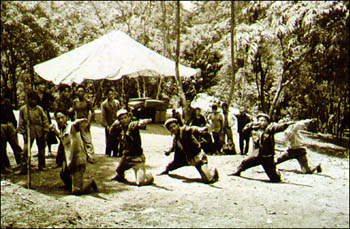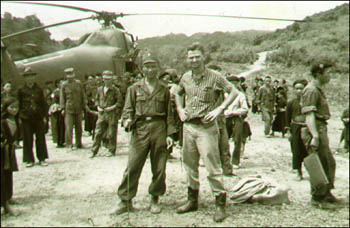The CIA’s ‘Secret War’
Friday, February 25, 2011
Decades after US forces exited the Vietnam War the remnants of a CIA-backed force of Lao villagers still live in fear in the jungle.

In a clearing deep inside the Laotian jungle, a group of Hmong fall to the groundand beg me for help as soon asthey see me. Chor Her, a skinny man wearing torn camouflage, is the only one toremain standing. He salutes before joining the others on the muddy ground.
‘We have no food, every day we have to run, we are being hunted like animals,’ says one elderly woman,weeping. The young children surrounding her are also crying—I’m told it’s the first time they’ve seen a foreigner. Indeed, these people have been largely cut off from the outside world since the Vietnam War.
Back then, the Hmong were fighters—secret fighters in a 15-year covert US operation backed by the CIA. Now they are forced to constantly run for their lives in a country whose government doesn’t officially acknowledge they exist.
‘The Americans gave us weapons and told us to shoot the enemy,’ says Chor Her, waving a battered CIA-issued M79 in the air. ‘Then they left us and we’ve been slowly dying here ever since…When the Lao Army kills one of our men, they feel as though they’ve killed an American in revenge for us helping them during the war.’
Almost before he has finished his sentence, another man jumps into the conversation, pleading for food and medicine. ‘We are human beings, so why does the world turna deafear and blind eye tous?’ he asks.
As the Vietnam War raged,Washington noticed that communist forces had spilled over into Laos. In response, the Americans launchedwhat was later called a secret war. At the time, Laos had been declared ‘neutral,’ but with a growing communist presence, the CIA saw it as the next front in the conflict. A handful of CIA agents were flown in to build on existing tensions between the Hmong and the Laotian government, led by the communist Pathet Lao.
‘They were better than anyone else around, every step they took was up or down so they could move a lot faster than the enemy,’ says Bill Lair, a legendary CIA agent who headed the agency’s paramilitary operations in Laos. ‘They needed a leader and Vang Pao seemed like the most suitable man for the job.’
Vang Pao, or ‘the General,’ was selected for his charisma and leadership skills,honed when the Hmong had previously allied with the French against North Vietnamese forces. With the help of the CIA, he reportedly trained and armed more than 60,000 Hmong fighters. While the Americans set up a major military airport in Northern Laos, the Hmong were in charge of disrupting communist supply lines and rescuing downed pilots.
It has been estimated that the Hmong lost nearly 100,000 people during this secret operation. As the war progressed, and with casualties quickly mounting, Vang Pao and his CIA backers eventually had to turn to the use of child soldiers to keep up the resistance efforts.
‘An American and a Thai man came into my school and I was taken away to military training,’ says Bou Than, a former Hmong soldier. Still only 13 years-old, the war was raging around him in the Laotian jungle. He was poached from a classroom and shipped straight off for military training.
‘I saw many of my school friends die in those jungles to help American forces,’ he says. ‘Kids as young as eight were being used.’
It’s rumored that at one point, Vang Pao said he wanted to cease all military operations with the CIA over concerns that the enormous loss of life could ultimately lead to the Hmong communities being wiped out altogether. Regardless of his intentions, though, the Hmong involvement continued—as did the casualties.
Soaring heroin sales were perhaps one thing that persuaded him to keep going. Before the Americans arrived, opium smoking was a cultural norm in the region and was prevalent throughoutthe Hmong highlands. US planes gave the Hmong the opportunity to do something they hadn’t previously—transport and sell large quantities of the drug, including to US soldiers.
There has been a great deal of debate since over the exact details of the operation, based on testimony given by CIA agents who were there at the time. But one thing is clear—there was a busy opium trade operating in the region, andthe agency appears to have turned a blind eye.
A number of CIA officers have claimed since that, fearing their operation could be embarrassingly exposed, they decided to give Vang Pao his own local airline, Xieng Kouang airlines, as part of a compromise following his demands for control of all of the agency’s planes.
Much of the opium that was produced is said to have ended up in the hands of American GIs on the frontlines, leading to a dramatic rise in the number of overdoses among soldiers. Yet despite this obvious drawback, those involved in the operation appear to have felt there was little they could do as the profits were, in effect, also helping to fund the war effort.
‘Opium grew everywhere in our highlands,’ says Tho Ther, a former Hmong soldier who now resides in the United States. ‘We smoked it openly, but it was only when the Americans came that our leaders began to sell it.’
‘We were losing countless male children for the CIA’s war and needed to pay to keep the villagers happy,’ he adds. ‘Otherwise they would have changed sides to save their men from joining our army.’
But it still wasn’t enough. The communist forces continued to grow in strength and advanced towards the CIA bases despite Washington’s best efforts—and $2 million a day spent carpet bombing Laos—to stop them. Accepting defeat, the Americans eventually fled, taking a handful of Hmong leaders, including Vang Pao.
With the Americans out of the picture, the Pathet Lao moved to try to wipe out the remaining Hmong elements that had worked with the CIA. But while thousands perished in aerial attacks on Hmong settlements—spurring a mass exodus to Thailand—the rest fled deeper into the jungle, where many remain today, still hoping the United States will return to save them.
Funeral for a Father
Earlier this month, thousands of mourners gathered in California for Vang Pao’s funeral. While an average Hmong usually receives a three-day funeral, owing to his stature among exiled Hmong, Vang Pao was given a six-day ceremony. While his critics have suggested his decision to support foreign forces led to his people suffering unnecessarily, the numbers attending the funeral demonstrated the loyalty he still inspired, with thousands of supporters flocking from locations as far away as France and Thailand to bid farewell to the symbolic head of a troubled people.
‘We call him “father.” He was always our leader and never turned his back on us, until his very last day,’ says Meng Lee, who attended the service.
In what turned out to be his final effort to secure some kind of lasting peace for his people, Vang Pao last year surprised followers by announcing a planned visit to Laos to meet government officials. The plan, revealed at a Hmong New Year dinner, was for him to make a peace deal with his former enemy on the Thai-Laotian border. Once peace had been agreed, Vang Pao planned to travel into Laos to assist the jungle Hmong. He hoped that those left in the jungle could then join repatriated refugees from Thailand on specially designated farmland, free from persecution.
But the Laotian government didn’t share this vision. In response to the proposal, Laos’ foreign minister is quoted as having said: ‘If he comes to Laos soon he must submit to the death sentence.’ The trip was cancelled.
The chillingresponse wasn’t entirely surprising—the Laotian government remains bitter over the role Vang Pao played in the Vietnam War. Ironically, then, the death of the would-be peacemaker might actually benefit the Hmong people, leaving space for a younger generation of ‘untainted’ leaders better able to avoid direct conflict with Vientiane. Still, the prospects for a breakthrough anytime soon seem remote.
No Foreign Friends?
Despite being home to more than 250,000 Hmong refugees, the United States has done little to try to resolve the ongoing tensions. In a recent meeting between US Secretary of State Hillary Clinton and Lao’s foreign minister in Washington, no mention seems to have been made of the persecuted Hmong.
The same can be said for Thailand, which allowed the forced repatriation of 4000 Hmong despite having trained many of Vang Pao’s forces. Thailand now also tops the list of Laos’ foreign investors.
Meanwhile, the Lao People’s Army continues to hunt down the remainder of the once formidable Hmong force. Always on the run, they have no time to harvest rice, so they survive largely by eating bugs and tree roots. Some of those who have surrendered in the past have returned to the jungle with stories of torture and rape. Without any form of foreign assistance, it seems likely most will eventually be found by the Army.
Shortly after Vang Pao’s death, speaking over a phone smuggled in by Hmong-American activists, Chor Fer says his group is struggling.
‘We’ve lost our father and don’t know what to do, we just keep running with nowhere to go,’ he says over a crackling line. ‘Every one of us wants to put an end to the war, but we know what will happen if we surrender. The communists will kill us.’
William Lloyd-George is a freelance journalist based on the Thai-Burma border. His work has appeared in TIME, The Independent, Bangkok Post, Afternposten, Irrawaddy and Global Post among others.
Source












